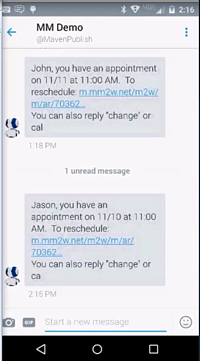Jul 11 2017 5 Benefits of Using Interactive Text Response

We’ve talked about customer engagement on this blog before – both how to screw it up, as well as how to get it right. Today, however, I want to take a more pragmatic and tactical approach to leveraging a technology to produce those high-value customer experiences that will help you retain customers, increase revenue and drive advocacy. Specifically Interactive Text Response (ITR) technology.
When developed and deployed appropriately, ITR can become the cornerstone of an effective customer experience and engagement strategy. One nice thing about this technology is that it can be leveraged and reused for multiple platforms, such as Twitter and Facebook Messenger, as well as the standard SMS text.
Most importantly, however, using ITR can help you realize the following critical benefits:
- Unobtrusive proactive engagement
- Reach millennials where they live
- Provide more feature-rich content
- Solicit germane feedback
- Increase the utilization of self-service
Unobtrusive Proactive Engagement
Unobtrusive: inconspicuous, unassertive
Proactive: anticipatory
Engagement: an appointment or arrangement, an encounter
Unassertive anticipatory encounters with your customers. You are acting on their needs, before they can ask about them. You are doing it in a way that is not threatening, nor does your encounter demand immediate attention, such as phone call may. You are creating the environment for an appointment that allows the customer to be participative in its scheduling and actionability.
Text messages achieve this unassertive anticipatory encounter status with your customers because text messages are considered to be unobtrusive. They do not demand the recipient’s immediate action. Those messages will sit in the text Inbox until they are acted upon by the recipient. They do not have to flash or beep or even notify the recipient. Until the recipient chooses to act upon the message, that message is completely benign.
A phone call, on the other hand, makes the recipient’s choice to not act much more difficult. First, there is the alerting of a call, which is usually more annoying than a text notification. Second, the opportunity to actually engage that phone call lasts until the ring times out – four rings is approximately 24 seconds. It is highly probable that I do not want to engage right now. If I do not answer, then my option would be to listen to a voicemail and or call the number back, placing any wait time on me (the recipient).
Text messages are not necessarily more anticipatory than a phone call or email. But they have the capability to be just as anticipatory as any other media channel. In this respect, a text message is not better, but it is every bit as good at alerting to an upcoming situation.
The medium of text is far better suited to fostering a low-effort encounter than a phone call or email, especially if the encounter requires a relatively small amount data or information. It is easy to embed a single-use expirable link in a text message that will enable the recipient to verify or modify specific information. A similar encounter using voice will require an agent to interpret information from the original recipient. Interpretation also opens the door for more error.
Reach Millennials Where They Live

By the numbers:
- Americans spend 26 minutes per day texting compared with six minutes on voice calls. (Chicago Tribune)
- Eighteen to 24 year olds exchange an average of 109.5 messages on a normal day. (Pew Research)
- 51 percent (or more) prefer text over other forms of communication. (Attentiv)
- One in four claim to socialize more online than in person. (Attentiv)
Millennials prefer NOT to talk to people on the other end of the communications channel. Increasingly, that desire extends to all other population segments. Sending a voice call to a person has a greater likelihood of that call being sent to voicemail or simply ignored.
Since the introduction of smart phones, modern people prefer texting and texting’s social cousins, such as Facebook and Twitter’s direct messaging features. Interactive Text Response leverages a variety of different communication preferences.
Provide More Feature-Rich Content
This Aspect video says this in a better way than I ever could. In short, text-based interactions provide a convenient, personalized, and relevant inbound and outbound method of self-service to a consumer. Here are some additional reasons as to why ITR is an efficient way to interact with customers:
-
- Text is the world’s fastest growing and easiest to use communications channel
- Preferred by 72 percent of customers over other service options
- ITR adds complete automation using the power of the cloud and Natural Language understanding
- No need to repeat a request “I’m sorry, I didn’t get that”
- No more closed hours “Please call back between 8 a.m. and noon”
- No more waiting on an agent
- No menu navigation requirements
ITR can be the world’s most convenient car manual, the most efficient method to confirm or reschedule an appointment, and the best way to perform notification and subsequent management tasks.
(Full-disclosure: MicroAutomation is an Aspect partner and routinely delivers the solutions you see in the video.)
Solicit Germane Feedback
Every well-run business wants to understand how it is doing and how it is perceived by its customers. Telephone calls, as we surmised before, are intrusive. Text messages (including standard SMS, Facebook or Twitter) are considered less intrusive and return that desired control to the customer. Embedding a link for a throw-away, online survey – allowing the customer to complete a targeted survey with just a few touches – has a much better chance of being used.
The result? Increased rates of response giving you that all-important feedback.
Increase the Utilization of Self-Service
Whether you realize it or not, your customers want to be able to handle their issues on their own:
- Over 50 percent of customers think it’s important to solve product issues themselves rather than rely on customer service. (Zendesk)
- Self-service usage increased from 67 percent in 2012 to 76 percent in 2014. (Forrester)
- 45 percent of companies offering web or mobile self-service have reported an increase in site traffic and a decrease in phone calls. (Destination CRM)
- 40 percent of customers prefer self-service to human contact. (Steven Van Belleghem)
- The IVR makes up 27 percent of all calls in the contact center, but only 7 percent of companies offer an IVR solution that delivers a better experience than live agents. (JD Power & Associates)
- 70 percent of customers prefer to use a company’s website to get answers to their questions rather than use phone or email. (Forrester)
So what do these numbers tell us?
Your customers are primed for self-service solutions. You can enable it by providing the content-rich features of a well developed ITR strategy. Do this by beginning with the end in mind. Gather customer opt-in, define the simple transactions and enable them, and increase their usage of the technology. Also, be sure to continually improve the interfaces, data, and services offered.
Before long, you will be in front of your industry. Not just in innovative technology. But, more importantly, in customer loyalty, increased profitability, and higher levels of advocacy.
Final Thought
Interactive Text Response provides a cost-effective, efficient means to upgrade the quality of your customers’ service interactions. The interface is familiar and preferred by 3/4 of your customers, and that amount still continues to rise. The question is not whether you will implement ITR, but when and how well will it be implemented?
